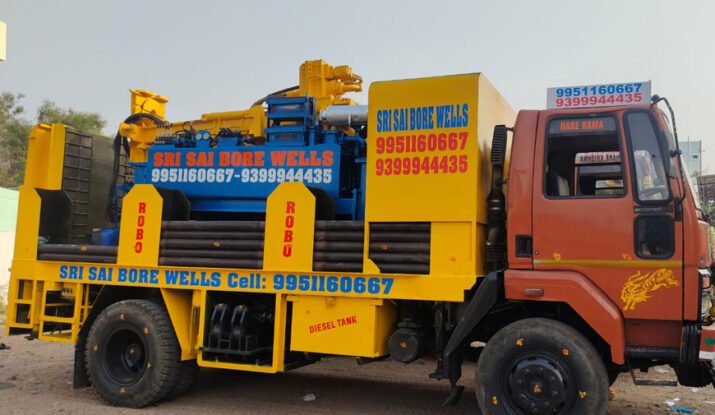Borewell drilling services generally their are into two main categories:
dug wells and tube wells. Dug wells are shallow, hand-excavated, while tube wells are deeper, machine-drilled boreholes that access groundwater. Within these categories, various drilling techniques like rotary, percussion, and auger drilling are used, depending on soil and rock conditions, and the desired depth.
Main Types of Borewell Drilling Services:
1. Dug Wells:
Dug wells are typically shallower than tube wells, often reaching a depth of about 30 meters (100 ft).
Hand Excavation:
They are dug by hand, making them suitable for areas where heavy machinery is not readily available or where shallow groundwater is present.
Lower Cost:
Due to the simpler construction process, dug wells are generally less expensive than tube wells.
2. Tube Wells:
Tube wells are drilled to greater depths, often reaching hundreds of feet to access deeper aquifers.
Machine Drilling:
They are drilled using specialized machinery, such as rotary, percussion, or auger rigs, depending on the geological conditions.
Higher Yield:
Tube wells are designed to tap into larger groundwater reserves, providing a higher water yield compared to dug wells.
Borewell drilling is a crucial solution for residential, agricultural, and industrial water supply. However, the type of borewell drilling service you choose can significantly impact the water yield, durability, and cost. At Sri Sai Borewells, we offer a wide range of borewell drilling services in Hyderabad, tailored to meet diverse requirements based on soil conditions, depth, and purpose.
METHODS OF BOREWELL DRILLING THAT DEPENDS ON SOIL SITUATION :
1. Rotary Borewell Drilling
Rotary drilling is one of the most common and efficient methods for borewell drilling . It uses a rotating drill bit to bore through soft or semi-hard soil layers.
Best For: Loose and alluvial soils
Drilling Depth: 200 to 1500 feet
Advantages: Fast drilling and suitable for deep borewells
borewell drilling in urban and peri-urban areas, rotary drilling is often the most cost-effective
borewell rotary drilling services in Hyderabad
2. DTH (Down-The-Hole) Drilling
DTH drilling is highly effective in hard rock formations. This method combines the hammering action of a percussion drill with rotary motion, enabling deeper and more accurate borewells.
Best For: Rocky terrains
Drilling Depth: 300 to 2000 feet
Advantages: Accurate and suitable for areas with low water tables
This service has high-performance results in challenging geological zones.
DTH borewell drilling
3. Manual Borewell Drilling
Manual drilling is a traditional method used in shallow borewells, especially in remote or rural locations where machine access is not supported to got in deep small streets.
Best For: Shallow agricultural or domestic borewells
Drilling Depth: Up to 100 feet
Advantages: Cost-effective and simple for short-term use
Farmers often prefer this for agriculture borewell is relatively high.
4. 6-Inch and 4.5-Inch Borewells
The borewell diameter significantly affects the discharge rate and pump size. We provide services for 6-inch borewell drilling commonly used for agriculture and 4.5-inch borewells for domestic use.
6-Inch Borewell Cost: Suitable for high water demand applications
4.5-Inch Borewell: Economical and ideal for homes
If you’re considering the borewell cost per feet, the diameter and depth are pricing factors.
5. Flushing and Borewell Cleaning Services
Apart from drilling, borewell cleaning service are essential for maintaining water quality. Flushing removes silt, sand, and blockages to restore water flow.
Explore our borewell flushing and cleaning services
6. Submersible Boring and Installation
We do submersible boring with pump installation, ensuring water supply for homes and farms.
Factors that Affect Borewell Drilling Service :
1.The type of soil and rock present at the drilling site will influence the choice of drilling method.
2.The depth to which the groundwater is located will determine whether a shallow dug well or a deeper tube well is needed.
3.The amount of water required will influence the size and type of borewell needed.
4.The cost of drilling and the availability of machinery will also play a role in the decision-making process.
Open bore well:
Open bore well type method are used to extract water found at the shallowest level in that area, which are typically found in unconfined shallow aquifers, i.e., soil or rock layers at shallow depths underground, in which water is held without any pressure
Tube well:
A tube well is a type of water well in which a long, 100–200 millimetres (3.9–7.9 in)-wide, stainless steel tube or pipe is bored underground. The lower end is fitted with a strainer, and a pump lifts water for irrigation. The required depth of the well depends on the depth of the water table
Deep Borewell:
Deep bore wells extend tens or hundreds of metres or yards underground and a very small diameter extraction borehole pump is lowered into the aquifer to extract the water. Pumps can be as small as 100 mm or 4” in diameter, but commonly 150 mm or 6” diameter pumps are used.
| Feature | Open Borewell | Tube Well | Deep Borewell |
|---|---|---|---|
| Depth | 30–50 feet | 100–200 feet | 500–2000+ feet |
| Diameter | 3–5 feet | 4–6 inches | 6 inches |
| Construction | Dug manually/mechanically | Drilled with rig | Drilled with DTH/rotary |
| Best For | Rural/domestic use | Domestic/small farms | Agriculture, industries |
| Contamination Risk | High | Low | Very Low |
Finally all of these an open borewell for traditional farming, a tube well for regular household water supply, or a deep borewell for high-demand irrigation


